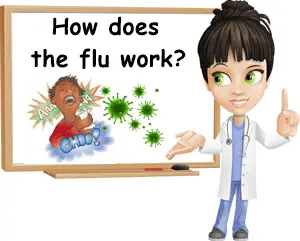Despite being the most common respiratory infection worldwide, not a lot of people know very much about the flu. And this lack of knowledge is at the center of most flu complications, lengthier and more difficult recoveries and improper symptoms management. Because in order to know how to prevent the flu and get over it fast you need to know how it works. More exactly, you need to have information on how the flu virus spreads and infects the body, how long it survives on surfaces, how long the flu takes to run its course and go away, what are its symptoms and, of course, the difference between the flu and the common cold. Knowing all of this can help anyone better prevent exposure to the virus, distinguish the infection from others and, consequently, better manage symptoms for a faster recovery. As such, here are 9 questions to ask yourself about the flu:
1) How long does the flu virus live on surfaces?
There are three major types of influenza viruses that can infect humans and each has several subtypes that mutate continuously. Some are quite contagious, others not so much. Depending on the type and subtype of influenza virus and any potential mutations it has suffered along the way, the virus may survive outside the body anywhere from a few minutes to up to 24 hours. Hard surfaces like doorknobs, handrails, desks, kitchen tables, counter tops, keyboards, computer mouse, remote controls, faucets or floors all typically allow the flu virus to survive the longest. But the virus typically doesn’t live more than a few minutes on soft surfaces like sheets, pillow cases, blankets or towels.

2) How does the flu virus spread?
Direct contact is the most contagious and includes people sneezing or coughing on you, directly transmitting the virus. Indirect contact is via objects infected by anyone sick with the flu such as doorknobs, desks or tables, but usually has a lower viral load and is, theoretically, less infectious.
3) How does the flu virus infect the body?
Entry points for the flu virus are the eyes, nose and mouth. For example, when someone sneezes in your direction or coughs on you, they release droplets of water, mucus and virus particles which enter the eyes, nose or mouth.
4) How does the flu virus work?
Once they enter the body, the virus particles travel to the respiratory tract and attach to cells. Their purpose is to transfer their genetic information to the cell nucleus and take over healthy cells. After successfully infecting a healthy cell, the virus will feed the cell nucleus its genetic material which allows it to replicate and produce more of its kind. In some cases, the cell dies and the virus copies are released. As the cell releases copies of the virus, the infection spreads.
5) How does the flu virus cause symptoms?
The actions of the flu virus do not go unnoticed. Actually, the immune system catches on pretty quickly that there are foreign elements in the body. As the flu virus replicates in the respiratory tract, it reaches immune system organs such as the tonsils, the adenoid tonsils or the patches of lymphoid tissue at the back of the tongue, all of which activate and the immune system response kicks in. The protocol is to learn about the virus and find out whether it’s never dealt with it before or has. If it has, there are memory cells which know exactly what antibodies to send. If it hasn’t, data is collected and unique antibodies are produced to deal with this pathogen specifically.

6) How long does the flu last in adults?
In a healthy person, flu symptoms usually start in 1-2 days after exposure to the virus, develop and reach a peak over the course of 2-4 days, after which they start decreasing in intensity and disappear. Overall, the flu should last 7-10 days in healthy adults. In severe infections, flu symptoms may last up to three weeks. In children, symptoms may easily last for two weeks or, if the infection is serious, up to a month.
7) How long does the flu fever last?
Typically 2-4 days, although not everyone sick with the flu also has fever. It is estimated that up to one third of persons sick with the flu do not experience fever. I can tell you I almost never got a fever when I had the flu. Certain factors may prolong the duration of the respiratory infection and, implicitly, its symptoms. For more information see full article on Influenza: Causes, Types, Symptoms and Treatment.
8) How long does the flu cough last?
This is probably the symptom most likely to persist even after the 7-10 days estimated duration of the respiratory infection. Some people report experiencing a residual cough up to a month after they get sick with the flu. A long-lasting cough may sometimes be indicative of a secondary infection, potentially bacterial in nature, so it’s best to check it out. You nose mucus color should give you better insight on the situation and tell you if you should see a doctor (see article on What Nose Mucus Color Means).
Even a thick, white mucus could in some cases be a result of a secondary bacterial infection, so it would be best you check it out because, normally, the flu does not cause excess mucus production (see article on White Mucus in Nose and Throat). Actually, cough from influenza should be dry, whereas cough from the common cold is productive.
9) What is the difference between flu and cold?
Believe it or not, influenza and the common cold are not that easy to tell apart. They both are respiratory infections caused by viruses, albeit different strains, and produce similar symptoms, just of different severity. But they both can get worse and so, difficult to tell apart. So what’s the difference?
Common cold symptoms are typically milder than those of the flu. For most people, the flu comes with fever, body aches, fatigue or even exhaustion and a certain malaise, all of which require bed rest. But a cold is something so many of us get around with, especially because it usually lacks fever, tiredness and aches and pains. Flu cough is typically dry, while cough from the common cold is productive. The flu causes chills alternating with the fever and can lead to fainting if you don’t rest, but a cold does not. Nasal congestion can be present with both, but is more common with colds. Lastly, the common cold causes a sore throat given the fact that cold viruses affect the upper respiratory tract, whilst with the flu chest discomfort is much more likely and often moderate to severe.
Because both the flu and cold are viral infections, they do not respond to antibiotics. Only when there is confirmation of a secondary bacterial infection should they be prescribed. Managing symptoms is the best possible treatment for both respiratory infections and includes drinking plenty of fluids, eating, resting and managing fever and cough with natural remedies and medication. Avoiding crowded places, especially in winter reduces risks of infection and frequent hand washing along with vaccination constitute the ultimate prevention available for the flu.
Conclusion
Knowing what causes the flu, how it works and what symptoms to expect are important pieces of information that teach us how to best tackle the respiratory infection for a fast and easy recovery. Understanding how influenza viruses spread teaches us how to best avoid getting sick with the flu, whereas knowing how long the flu is supposed to last and what are the differences between it and the common cold help us identify the condition and get ahead of complications.
